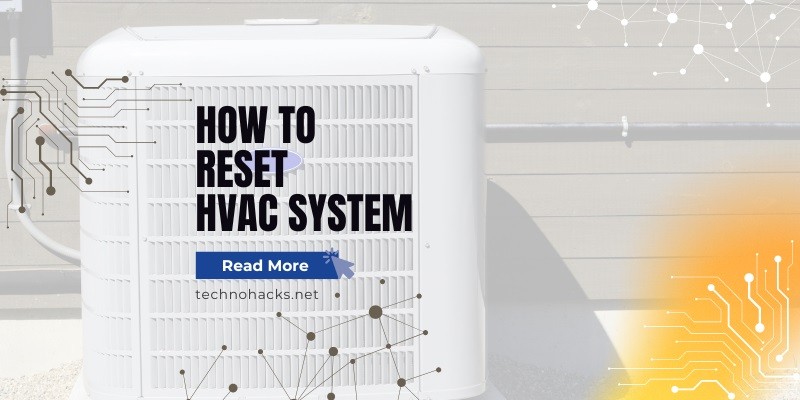Last Updated on May 5, 2025 by Jim C.
Resetting your HVAC (Heating, Ventilation, and Air Conditioning) system can often resolve minor issues and restore proper functioning without the need for professional intervention. This guide will walk you through the process of resetting your HVAC system, explain when it’s necessary, and provide troubleshooting tips to help you maintain optimal performance.
When to Reset Your HVAC System
There are several situations where resetting your HVAC system may be beneficial:
- After a power outage: Power surges or interruptions can cause your system to malfunction.
- When the system isn’t responding to thermostat settings: If your HVAC isn’t cooling or heating as expected, a reset might help.
- After a tripped circuit breaker: Electrical issues can cause your system to shut down unexpectedly.
- When the system is blowing warm air instead of cool (or vice versa): This could indicate a minor glitch that a reset might fix.
- If the system fails to start: A reset can sometimes jumpstart a non-responsive unit.
Safety Precautions Before Resetting
Before attempting to reset your HVAC system, it’s crucial to prioritize safety:
- Turn off the power: Always ensure the system is completely powered down before attempting any reset procedure.
- Consult the manual: Refer to your manufacturer’s manual for specific instructions related to your model.
- Use proper personal protective equipment (PPE): When working with HVAC systems, it’s advisable to wear safety goggles, gloves, and appropriate footwear.
Step-by-Step Guide to Resetting Your HVAC System
1. Using the Reset Button
Many HVAC units have a dedicated reset button, typically located on or near the outdoor unit.
- Locate the reset button: It’s usually a small, red button labeled “RESET.”
- Turn off the system: Switch off the thermostat and the HVAC unit.
- Press and hold the reset button: Hold for 3-5 seconds, then release.
- Turn the system back on: Wait a few minutes, then turn the thermostat to the desired setting.
2. Resetting via Circuit Breaker
If your system doesn’t have a reset button or the button method doesn’t work, try resetting via the circuit breaker.
- Locate the circuit breaker box: Usually found in the basement, garage, or utility area.
- Find the HVAC breaker: Look for a switch labeled “AC,” “HVAC,” or “Air Conditioner.”
- Turn off the breaker: Flip the switch to the “OFF” position.
- Wait 30 seconds: This allows the system to fully reset.
- Turn the breaker back on: Flip the switch back to the “ON” position.
3. Using the Isolation Switch
Some HVAC systems have an isolation switch, typically located near the outdoor unit.
- Find the isolation switch: It often looks like a regular light switch.
- Turn off the switch: Flip it to the “OFF” position.
- Wait 30 minutes: This allows all electrical components to fully reset.
- Turn the switch back on: Flip it to the “ON” position and restart your system.
4. Resetting the Thermostat
Sometimes, the issue may lie with the thermostat rather than the HVAC unit itself.
- Turn off the thermostat: Switch it to the “OFF” position.
- Remove the thermostat cover: Locate the reset button inside.
- Press and hold the reset button: Hold for about 5 seconds.
- Replace the cover and turn on the thermostat: Set it to the desired temperature and check if the system is working.
Troubleshooting Tips
If resetting doesn’t solve the problem, try these troubleshooting steps before calling a professional:
- Check the air filter: A dirty filter can restrict airflow and cause system issues. Clean or replace it if necessary.
- Inspect for vent blockages: Ensure all vents are open and unobstructed by furniture or debris.
- Examine the outdoor unit: Clear any debris around the unit that might be impeding airflow.
- Check thermostat batteries: If your thermostat is battery-operated, try replacing the batteries.
- Look for unusual noises: Strange sounds can indicate mechanical issues that may require professional attention.
- Verify power supply: Ensure there are no issues with the electrical supply to your HVAC unit.
When to Call a Professional
While many HVAC issues can be resolved with a simple reset or basic troubleshooting, some situations require professional intervention:
- Frequent resets needed: If you find yourself resetting the system often, there might be an underlying issue.
- Persistent problems: If the system doesn’t respond to resets or continues to malfunction, it’s time to call an HVAC technician.
- Electrical issues: If you suspect any electrical problems, it’s safer to consult a professional.
- Strange odors or sounds: Unusual smells or noises could indicate serious mechanical issues.
- Refrigerant leaks: If you suspect a refrigerant leak, that can be harmful, contact a professional immediately.
- Annual maintenance: Even if your system seems to be working fine, it’s recommended to have a professional inspection once a year.
Importance of Regular Maintenance
Regular maintenance is crucial for the longevity and efficiency of your HVAC system. Here are some key reasons:
- Prevents breakdowns: Regular check-ups can identify and address potential issues before they become major problems.
- Improves efficiency: A well-maintained system operates more efficiently, potentially reducing energy costs.
- Extends system lifespan: Proper care and maintenance can significantly extend the life of your HVAC system.
- Ensures safety: Regular inspections can detect safety hazards like gas leaks or electrical issues.
- Maintains warranty: Many warranties require regular professional maintenance to remain valid.
Conclusion
Knowing how to reset your HVAC system and perform basic troubleshooting can save you time and money on minor issues. However, it’s important to recognize when a problem is beyond your expertise and requires professional attention. Regular maintenance and prompt addressing of issues will help ensure your HVAC system operates efficiently and reliably for years to come.

